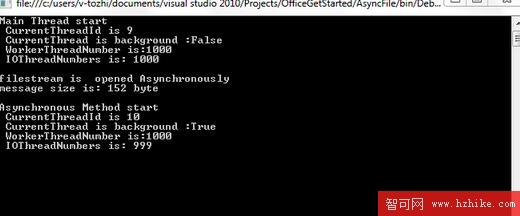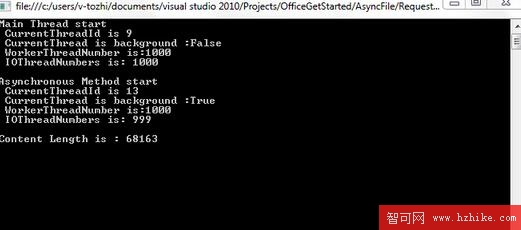一、I/O線程實現對文件的異步
1.1 I/O線程介紹:
對於線程所執行的任務來說,可以把線程分為兩種類型:工作者線程和I/O線程。
工作者線程用來完成一些計算的任務,在任務執行的過程中,需要CPU不間斷地處理,所以,在工作者線程的執行過程中,CPU和線程的資源是充分利用的。
I/O線程主要用來完成輸入和輸出的工作的,在這種情況下, 計算機需要I/O設備完成輸入和輸出的任務,在處理過程中,CPU是不需要參與處理過程的,此時正在運行的線程將處於等待狀態,只有等任務完成後才會有事可做, 這樣就造成線程資源浪費的問題。為了解決這樣的問題,可以通過線程池來解決這樣的問題,讓線程池來管理線程,前面已經介紹過線程池了, 在這裡就不講了。
對於I/O線程,我們可以將輸入輸出操作分成三個步驟:啟動、實際輸入輸出、處理結果。用於實際輸入輸出可由硬件完成,並不需要CPU的參與,而啟動和處理結果也可以不在同一個線程上,這樣就可以充分利用線程資源。在.Net中通過以Begin開頭的方法來完成啟動,以End開頭的方法來處理結果,這兩個方法可以運行在不同的線程,這樣我們就實現了異步編程了。
1.2 .Net中如何使用異步
注意:
其實當我們調用Begin開頭的方法就是將一個I/O線程排入到線程池中(調用Begin開頭的方法就把I/O線程加入到線程池中管理都是.Net機制幫我們實現的)。
(因為有些人會問什麼地方用到了線程池了,工作者線程由線程池管理很好看出來,因為創建工作者線程直接調用ThreadPool.QueueUserWorkItem方法來把工作者線程排入到線程池中)。
在.Net Framework中的FCL中有許多類型能夠對異步操作提供支持,其中在FileStream類中就提供了對文件的異步操作的方法。
FileStream類要調用I/O線程要實現異步操作,首先要建立一個FileStream對象。
通過下面的構造函數來初始化FileStream對象實現異步操作(異步讀取和異步寫入):
public FileStream (string path, FileMode mode, FileAccess Access, FileShare share,int bufferSize,bool useAsync)
其中path代表文件的相對路徑或絕對路徑,mode代表如何打開或創建文件,Access代表訪問文件的方式,share代表文件如何由進程共享,buffersize代表緩沖區的大小,useAsync代表使用異步I/O還是同步I/O,設置為true時,說明使用異步I/O.
下面通過代碼來學習下異步寫入文件:
using System;
using System.IO;
using System.Text;
using System.Threading;
namespace AsyncFile
{
class Program
{
static void Main(string[] args)
{
const int maxsize = 100000;
ThreadPool.SetMaxThreads(1000,1000);
PrintMessage("Main Thread start");
// 初始化FileStream對象
FileStream filestream = new FileStream("test.txt", FileMode.OpenOrCreate, FileAccess.ReadWrite, FileShare.ReadWrite, 100, true);
//打印文件流打開的方式
Console.WriteLine("filestream is {0} opened Asynchronously", filestream.IsAsync ? "" : "not");
byte[] writebytes =new byte[maxsize];
string writemessage = "An Operation Use asynchronous method to write message.......................";
writebytes = Encoding.Unicode.GetBytes(writemessage);
Console.WriteLine("message size is: {0} byte\n", writebytes.Length);
// 調用異步寫入方法比信息寫入到文件中
filestream.BeginWrite(writebytes, 0, writebytes.Length, new AsyncCallback(EndWriteCallback), filestream);
filestream.Flush();
Console.Read();
}
// 當把數據寫入文件完成後調用此方法來結束異步寫操作
private static void EndWriteCallback(IAsyncResult asyncResult)
{
Thread.Sleep(500);
PrintMessage("Asynchronous Method start");
FileStream filestream = asyncResult.AsyncState as FileStream;
// 結束異步寫入數據
filestream.EndWrite(asyncResult);
filestream.Close();
}
// 打印線程池信息
private static void PrintMessage(String data)
{
int workthreadnumber;
int iothreadnumber;
// 獲得線程池中可用的線程,把獲得的可用工作者線程數量賦給workthreadnumber變量
// 獲得的可用I/O線程數量給iothreadnumber變量
ThreadPool.GetAvailableThreads(out workthreadnumber, out iothreadnumber);
Console.WriteLine("{0}\n CurrentThreadId is {1}\n CurrentThread is background :{2}\n WorkerThreadNumber is:{3}\n IOThreadNumbers is: {4}\n",
data,
Thread.CurrentThread.ManagedThreadId,
Thread.CurrentThread.IsBackground.ToString(),
workthreadnumber.ToString(),
iothreadnumber.ToString());
}
}
}
運行結果:

從運行結果可以看出,此時是調用線程池中的I/O線程去執行回調函數的,同時在工程所的的bin\Debug文件目錄下有生成一個text.txt文件,打開文件可以知道裡面的內容正是你寫入的。
下面演示如何從剛才的文件中異步讀取我們寫入的內容:
using System;
using System.IO;
using System.Text;
using System.Threading;
namespace AsyncFileRead
{
class Program
{
const int maxsize = 1024;
static byte[] readbytes = new byte[maxsize];
static void Main(string[] args)
{
ThreadPool.SetMaxThreads(1000, 1000);
PrintMessage("Main Thread start");
// 初始化FileStream對象
FileStream filestream = new FileStream("test.txt", FileMode.OpenOrCreate, FileAccess.ReadWrite, FileShare.ReadWrite, 100, false);
// 異步讀取文件內容
filestream.BeginRead(readbytes, 0, readbytes.Length, new AsyncCallback(EndReadCallback), filestream);
Console.Read();
}
private static void EndReadCallback(IAsyncResult asyncResult)
{
Thread.Sleep(1000);
PrintMessage("Asynchronous Method start");
// 把AsyncResult.AsyncState轉換為State對象
FileStream readstream = (FileStream)asyncResult.AsyncState;
int readlength = readstream.EndRead(asyncResult);
if (readlength <=0)
{
Console.WriteLine("Read error");
return;
}
string readmessage = Encoding.Unicode.GetString(readbytes, 0, readlength);
Console.WriteLine("Read Message is :" + readmessage);
readstream.Close();
}
// 打印線程池信息
private static void PrintMessage(String data)
{
int workthreadnumber;
int iothreadnumber;
// 獲得線程池中可用的線程,把獲得的可用工作者線程數量賦給workthreadnumber變量
// 獲得的可用I/O線程數量給iothreadnumber變量
ThreadPool.GetAvailableThreads(out workthreadnumber, out iothreadnumber);
Console.WriteLine("{0}\n CurrentThreadId is {1}\n CurrentThread is background :{2}\n WorkerThreadNumber is:{3}\n IOThreadNumbers is: {4}\n",
data,
Thread.CurrentThread.ManagedThreadId,
Thread.CurrentThread.IsBackground.ToString(),
workthreadnumber.ToString(),
iothreadnumber.ToString());
}
}
}
這裡有個需要注意的問題:如果大家測試的時候, 應該把開始生成的text.txt文件放到該工程下bin\debug\目錄下, 我剛開始的做的時候就忘記拷過去的, 讀出來的數據長度一直為0(這裡我犯的錯誤寫下了,希望大家可以注意,也是警惕自己要小心。)
二、I/O線程實現對請求的異步
我們同樣可以利用I/O線程來模擬對浏覽器對服務器請求的異步操作,在.Net類庫中的WebRequest類提供了異步請求的支持,
下面就來演示下如何實現請求異步:
using System;
using System.Net;
using System.Threading;
namespace RequestSample
{
class Program
{
static void Main(string[] args)
{
ThreadPool.SetMaxThreads(1000, 1000);
PrintMessage("Main Thread start");
// 發出一個異步Web請求
WebRequest webrequest =WebRequest.Create("http://www.cnblogs.com/");
webrequest.BeginGetResponse(ProcessWebResponse, webrequest);
Console.Read();
}
// 回調方法
private static void ProcessWebResponse(IAsyncResult result)
{
Thread.Sleep(500);
PrintMessage("Asynchronous Method start");
WebRequest webrequest = (WebRequest)result.AsyncState;
using (WebResponse webresponse = webrequest.EndGetResponse(result))
{
Console.WriteLine("Content Length is : "+webresponse.ContentLength);
}
}
// 打印線程池信息
private static void PrintMessage(String data)
{
int workthreadnumber;
int iothreadnumber;
// 獲得線程池中可用的線程,把獲得的可用工作者線程數量賦給workthreadnumber變量
// 獲得的可用I/O線程數量給iothreadnumber變量
ThreadPool.GetAvailableThreads(out workthreadnumber, out iothreadnumber);
Console.WriteLine("{0}\n CurrentThreadId is {1}\n CurrentThread is background :{2}\n WorkerThreadNumber is:{3}\n IOThreadNumbers is: {4}\n",
data,
Thread.CurrentThread.ManagedThreadId,
Thread.CurrentThread.IsBackground.ToString(),
workthreadnumber.ToString(),
iothreadnumber.ToString());
}
}
}
運行結果為:

寫到這裡這篇關於I/O線程的文章也差不多寫完了, 其實I/O線程還可以做很多事情,在網絡(Socket)編程,web開發中都會用I/O線程,本來想寫個Demo來展示多線程在實際的工作中都有那些應用的地方的, 但是後面覺得還是等多線程系列都講完後再把知識一起串聯起來做個Demo會好點,至於後面文章中將介紹下線程同步的問題。